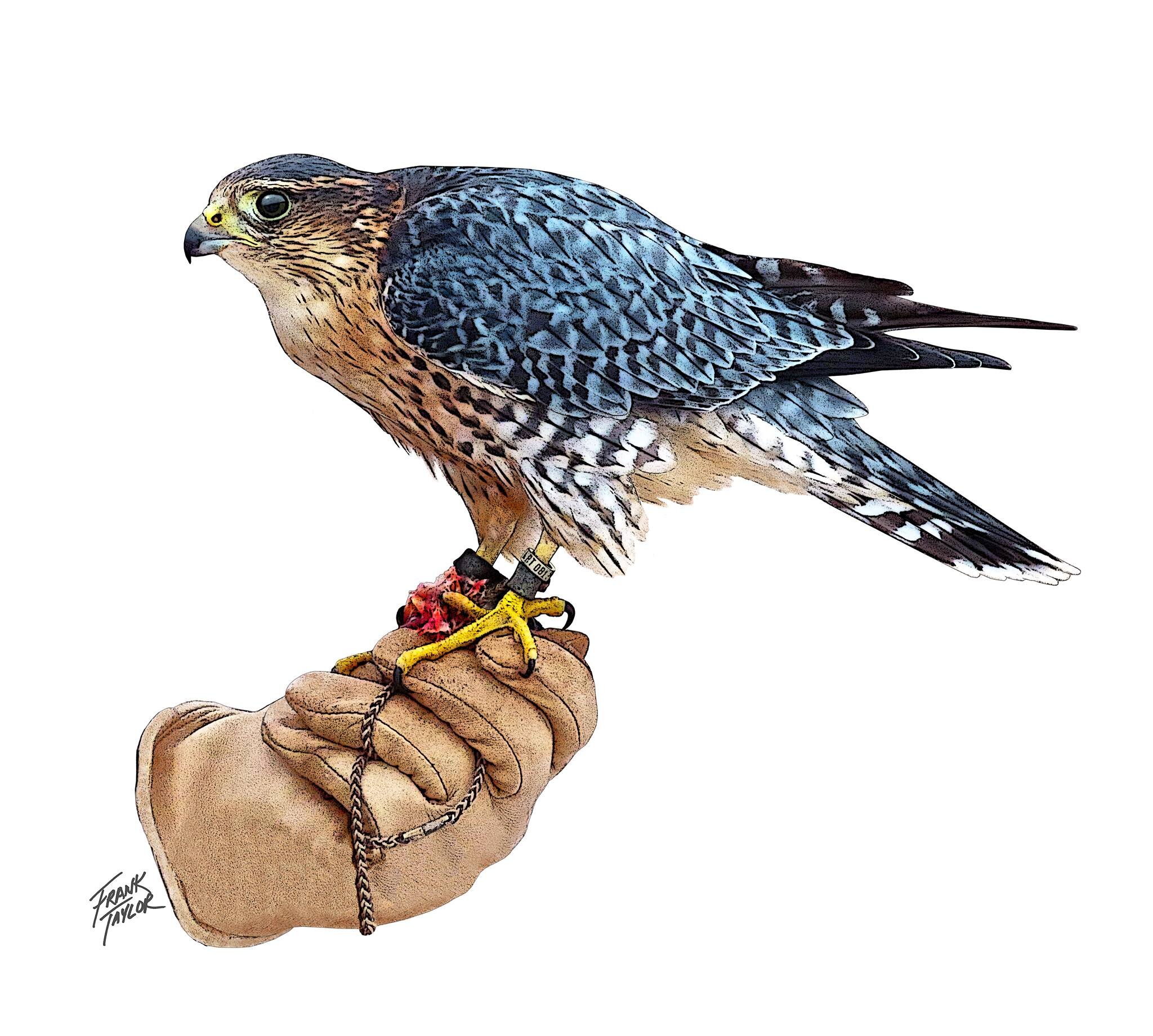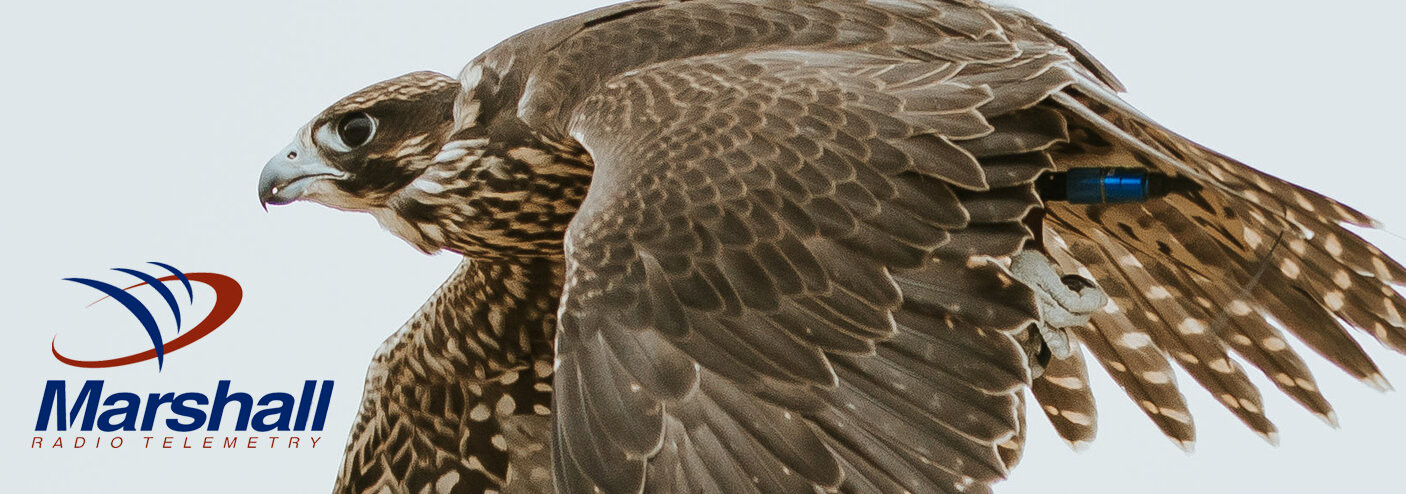The Stoop of the Perlin
A dust cloud trails the convoy of eight vehicles moving through the prairie hills northwest of Great Bend, Kansas. A gentle breeze whisks it away as the lead vehicle slows and brings the group to a halt between a tilled field and a cut plot bordered with tall, wild grasses. Near the back of the procession, we prepare to get out, but then there’s some commotion ahead and the line u-turns, one by one. Ahead of us in a height-adjusted Tesla Model X, Robert Bagley & the Marshall Radio team cross the shallow ditch bordering the road, driving across the turned soil of the field before regaining the road, it’s comical. A few minutes later and the convoy has returned to the opposite border of the same field, this time, everyone starts getting out.
All I know about what’s going on comes from Zane Muhlestein excitedly suggesting we join the party departing the NAFA meet hotel. “Daniel Murray is flying his perlin, he caught a bird yesterday and is going for them again today. I’d love to see that this is a rare opportunity!” With no other plans, I hop in his truck and here we are. Because of how uncommon they are, I’d never really given the peregrine/merlin cross much thought, my only knowledge of them really comes from a talk given by Louise Engel at the 2018 Utah Merlin Meet raffle, where she discussed flying her perlin on large flocks of starlings in Canada. Interesting, but micros have never really been “my thing.”
This time however, my interest was piqued. A “jack” (male/tiercel) perlin on small game from a pitch is what Zane was saying was about to go down, and I wanted to see it. Perlin crosses are uncommon, I personally only know two people flying them currently, the aforementioned Louise in Canada and now Daniel Murray—here about to fly his before our very eyes. Granted, I’m not really in the loop of these types of exotic crosses. With no personal breeding experience, I can’t posit that actually producing them is difficult, though I’d assume it’s not easy with the exaggerated biological differences between a peregrine falcon which we’d usually refer to as being among the “large long-wings” and a merlin which is what we generally classify as a “micro.” It’s keeping them alive that seems to be the hard part, or so the rumors go. Apparently they become target number one for nearly every other raptor and animal within several miles of anywhere they are being flown. My interest is piqued because I want to know why that could be… Why would this cross be singled out more than a merlin or tiercel peregrine?
Five seasons of hard hawking seems to have earned this male perlin named “Stinger” the status of odd one out. It’s also earned him quite the reputation. From the first day of the meet, there was buzz being generated about him. But more broadly, you’re hardly involved in the falconry community if you haven’t heard mention of Stinger the Perlin. It’s one thing to possess an exotic raptor with a reputation for getting eaten by everything from red-tailed hawks to Cooper’s hawks, it’s an entirely different thing to fly them, and hunt them hard. It’s daring, it’s macho, and the excitement of the crowd assembling along the edge of the road pointing and holding phones out as Stinger explodes into the sky is well placed.
Photo of “Stinger” on the wing, courtesy of Christian Hagenlocher
It’s captivation from the first wingbeat. I’ve never seen anything fly like this. Frankly, I don’t quite know what I’m seeing. In terms of appearance of the bird, it’s literally what you’d imagine a peregrine/merlin cross would look like, it’s built like a mixture of both, and appears slightly smaller than a tiercel peregrine. But its wingbeat and zeal is hard to explain, both the pattern of its motions and also the power with which it races forward defies what my brain has come to expect of falcons. Its unbridled torque and passion, in a small, inconspicuous package. Within seconds Stinger has darted out low across the rough cut field and then arcs with breathtaking speed directly up into the array of melded pink hues that has become of the once azure, big-country sky.
At this point I’ve pieced together why Daniel and the leaders at the front of the line had repositioned the convoy they way they did. Previous scouting had given them beta on this particular area, and they had merely stopped to glass the corner of the field the party was now moving into, to make sure the birds were indeed still here. Then we’d driven the far way around so as not to disturb them quite yet, but also to put Stinger in the best position to do his work. The area we were now hunting is at the foot of a hill, cornered in the intersection of two dirt roads. Runoff on the fields has formed a ditch, both cutting down the hill but also along the road, and thus being unsuitable for tractors and farming, tall prairie grasses have grown unchecked. This is the type of habitat these birds love, as they can move from feeding in the adjacent fields into the cover of the tall grass. Daniel instructs the onlookers willing to participate to form a line to flush the birds from the field, where they’ll then have to make a hasty dash for cover under the menacing watch of Stinger. Overhead, Stinger’s presence has the birds frozen in fear. But with less than a hundred yards of open field between where they are holding tight, Daniel informs us they’re going to have a slight advantage today.
I’ll take liberty to expose my ignorance here. Observing the stage being set before me, I was fully expecting the perlin to take a “pitch” (whatever that is for a perlin) before getting off a single stoop which, accounting for the nature of falconry, he’d most likely miss, and that would be it, show’s over. How wrong I was.
In just a few seconds Stinger is nearly 300 feet above us, with the line of flushers moving into the field. I couldn’t believe the breakneck speed with which he’d circled up, gobbling altitude like gravity doesn’t exist. This is a fit falcon! Then to a chorus of excited cries a bird is up and rapidly making its escape diagonally away from the group, then another one flushes and cuts straight through the group, flying over the cars and opposite the intended direction! Like a guided missile, Stinger locks on to the first one, and cranks down in a dazzling stoop, nearly plucking the hapless prey from the air, except the safety of the grasses proved too near as the bird bailed into cover, inches from its demise. “Everybody freeze and let him remount!” Daniel calls out, and sure enough Stinger is already nearing 200 feet, the momentum from his stoop propelling him halfway back to pitch before he even needs further wing pumping for height. The line begins moving again, and at this point I am struck with my own theory for why everything wants to eat perlins.
Photo of “Stinger” in a stoop, courtesy of Christian Hagenlocher
Again this may be totally off-point, but as it stood out to me so strongly standing there watching it I now convey my theory here… At pitch, this perlin flies like a flicker, or some sort of other small prey bird. A set of rapid beats with a sharp upward trajectory, then wings set tightly to the body in a gentle downward swing, then rapid pumping back up, then set and almost falling downward. Evidently an effective way to maintain pitch, but resoundingly appearing more like a prey species than a predatory bird. It seems bizarre, and is definitely attention grabbing. I could imagine a red-tailed hawk a mile away would instantly have his attention pulled towards this erratic flying bird. I’d attribute it to the strange biomechanics of two distinctly different falcons being artificially crossed, it definitely is not natural. In the wild, unnatural is not tolerated.
But Stinger has survived for five legendary seasons and today’s exemplary performance by him will showcase his efficiency and prove his mettle. He’s not just a survivor, he’s a thriver. “HO HO HO!” and several more birds are flashing up from before the group and beelining towards the ditch! Again Stinger doesn’t hesitate, instantly making calculations and picking his best shot out of the three targets, grabbing some speed on the go with several quick, jerking wingbeats before locking into bullet-form for a searing stoop on the second bird to mount up. Something about this bird earned his selection. Maybe it was the slowest flyer. Maybe it hesitated, or exhibited some behavior only detectable to the lighting-fast analytical mind of a seasoned falcon. Either way it too almost met its fate before plunging haphazardly into the ditch, a hair’s breadth from the clutches of the falcon—the wind of which ripping by had tumbled the bird in a somersault into cover. Shaken, but safe.
G-Forces, anti-gravity, logic-defying whatever, Stinger was somehow already back up to pitch. Invigorated by his second near miss, un-phased by the amount of energy exerted so far, scanning the group of humans now rising from a crouch and moving again. This was everything Stinger lived for, that much was clearly evident. In two words I would describe Stinger’s style of hunting as “gracefully erratic.” In thrilling fashion he’d launch one, two, three more stoops on birds, which as the group continued across the field, were ever closer to cover on flush. Stinger seemed to be here, there, everywhere, but then always back up to a pitch of what looked to me of at least 150 to 200 feet.
The group crouches as Stinger mounts back up to pitch, iPhone photo courtesy of Robert Bagley
It’s a compelling facet of falconry, all this adrenaline and excitement, but yet taking place in so serene an environment. Standing apart from the crowd, the subtle breeze carries the cool evening air across my skin, bringing with it soft scents of dry soil and the remains of harvested crops. An oil pumpjack slowly churns, a garish contrast to the gentle landscape, but yet somehow not out of place before this picturesque Kansas sunset. Nearly to the tall grasses rising from the drainage ditch, the group of falconers—many of them strangers to each other—work in unison with Daniel Murray and his falcon, all of their individual worries and cares forgotten, enraptured in the moment. Soaking in their shared passion and appreciation for the art. From a distance away, it appears surreal. To quote Tim Jessell, “falconry shows us that there’s still a bit of magic in the world.”
Stinger commandeers my attention as he sizzles past me, making short work of the distance between himself and the lone bird that had held tight before flushing behind the group and heading the opposite way, but again the cover forming a 90° angle into the corner of the field worked against him, with the panicked prey skimming low to the ground in a tight banking turn, throwing the heavier falcon into a slightly wider turn which would buy just enough space for cover to be reached. Stinger continued in his turn, crossing the area where the bird had put in twice, as if frustratedly marking the spot, before cruising over and upwards back over the group.
I’ve never seen anything like this. Eight stoops, each time regaining pitch, with what appeared to be no adverse effect on his stamina and energy. For a falconer, especially a long-winger, this was addicting, this was the drug of the stoop administered over and over again. This is why legendary falconers Steve Chindgren, Dr. Pat Redig, Frank Taylor, Doug Pineo, and so many others at this meet would be in attendance to watch Stinger’s prowess. This is why Robert Bagley brought the Marshall Radio team out to watch this little guy, enabled and secured by the micro-transmitter sporting the Marshall logo about his leg. This was high stakes high reward falconry, supercharged. This little falcon was a showboater, but with a track-record to back up his flashy antics and style of flight. There were so many times where I would look over to catch Robert shaking his head in disbelief, a smile plastered on his face. High octane fun, pure and unadulterated. Following several more stoops, Daniel Murray conceded that his hunch on the nearness of cover being too great an advantage for the prey was correct, and Stinger zipped down to claim his reward on the lure. Having made a kill the day before, there was no sense in pushing any longer, Stinger would rest up and take one tomorrow. Which he did, by the way.
Everybody that shares the privilege of watching Stinger work his magic will be moved by him. Mentally, emotionally, spiritually, this dynamic little hybrid’s larger than life attitude and charisma will win anybody’s heart, and leave you with a sense of gratitude for having witnessed his artwork… each stoop, turn, lift, another brushstroke of his masterpiece across the canvas sky.
Daniel Murray with “Stinger” courtesy of Christian Hagenlocher
Kansas sun setting over the convoy of falconers and enthusiasts gathered to watch Daniel Murray’s “Stinger”, iPhone photo courtesy of Robert Bagley.
Special thank you to Christian Hagenlocher, founder of The Birding Project, for providing the photography for this piece. Additional thanks to Frank Taylor for providing the “Hybrid Photo-Digital Art". Also thanks to Robert Bagley for the great iPhone photos, more of which can be found on his Instagram.










